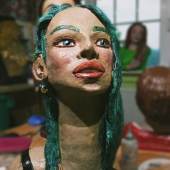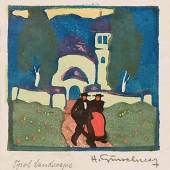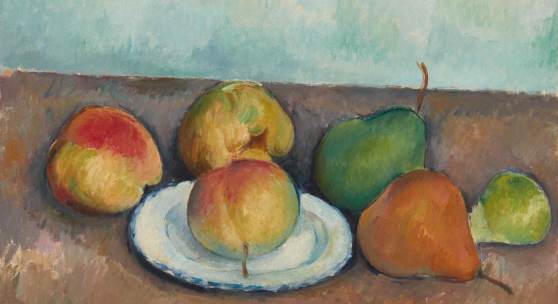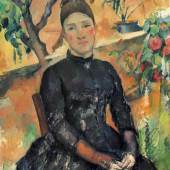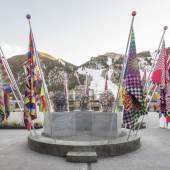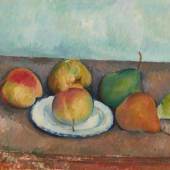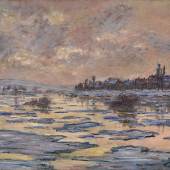Sotheby's to Offer $25 Million Paul Cézanne Still Life Alongside Masterworks by Monet & Degas in Impressionist & Modern Art Evening Sale | Auction 12 May in New York
-
Presse13.04.2021
Unlike some of Cézanne’s earlier works, which faithfully transcribed the appearance of the furnishings, paneling and wallpaper around him, the emphasis in Nature morte: pommes et poires falls exclusively on the fruit. In contrast to his later still lifes, in which the more flamboyant compositions are constructed with architectural white cloths or colorful drapes, the objects in the present work are laid in a forward-facing arc which repeats the quiet ellipse of the plate.
With these simple and delicate touches, Cézanne achieves a painting of classic harmony while simultaneously providing the future generation of painters a blueprint for Modernist painting and sculpture through an understated yet persistent challenge of traditional perspective. A motivating force behind the revolutionary Cubist compositions of Picasso and Braque, who would demonstrate a similar dedication to challenging perspective, Cézanne’s continual experimentation and the planar distortions best evinced in his still lifes directly impacted the way a future generation of artists would view the world and their artistic practice. Masterworks such as Nature morte: pommes et poires would cement Cézanne’s legacy as a pioneering artist and would help define art of the 20th century.
Widely exhibited and acclaimed, Edgar Degas’s Danseuse is an exquisite example of the artist’s most iconic motif, capturing the splendor and grace of the Parisian ballet. Once in the collection of the Museum of Fine Arts, Boston for nearly 70 years, this enchanting pastel illustrates Degas’s remarkable deftness in the medium, exemplified in the layered strokes of white, ochre and light blue surrounding the ballerina’s gauzy tutu, and demonstrates his genius for rendering color and his inimitable control over this medium.
The present composition is the most complex and delicately rendered of a small number of related works, which feature dancers in the same pose against varying backdrops. Though this fascination with form was constant throughout his career, Degas’s focus on the human figure in motion more fully evolved in the 1870s as he began working increasingly in pastel. In doing so, Degas was endowed with a greater sense of freedom in his work that allowed him to manually smudge and blend the pigment throughout the composition, as witnessed in the present work around the dancer’s tutu. The figure in the present work is believed to be Marie van Goethem, dancer for the Paris Opera Ballet at the Palais Garnier, who also modeled for Degas's celebrated bronze, Petite danseuse de quatorze ans, which he completed a few years prior and which attests to his devoted study across mediums.
From the 1870s, Degas frequented the Palais Garnier venue, which not only provided entertainment, but also ample opportunity for the artist to observe and draw the human form in motion, as well as capture the fanciful costumes and sets that decorated the stage. Attending operas and ballets, Degas astutely observed both the performances and the lives of the dancers behind the scenes. While many of his later Danseuses images focus on quiet backstage moments between acts, his most compelling works feature dancers who come alive on stage under the bright light of the theater.
True to form, the present work showcases Degas’s unusual perspective. The artist focuses on the lone dancer, transporting the viewer to the theatrical realm where one feels a part of the kaleidoscopic landscape. Deviating from the traditional Western perspective popularized during the Renaissance, Degas’s dramatic cropping produces a heightened sense of drama and immediacy in his compositions. Such unorthodox perspective draws on the influence of Japanese woodblock prints, which became fashionable in Paris during this period and notably influenced the work of Degas’s contemporaries, such as Henri Toulouse-Lautrec and Vincent Van Gogh.
Two outstanding paintings by Claude Monet round out this illustrious group: La Seine à Lavacourt, Débâcle from 1880 and Fleurs dans un pot (Roses et brouillard) from 1878. La Seine à Lavacourt, Débâcle is an extremely rare and relatively unseen work that was also formerly in the George Vanderbilt collection; in fact, it went on to hang at the Biltmore Estate. Painted during the winter of 1879-1880, which was one of the coldest on record in Europe, Monet captured the freeze and thaw of the Seine at different times of day throughout a series of works composed en plein air, braving the cold to record history, and thereby effectively creating history himself: this series is often considered Monet’s first, paving the way for the series images he would later paint of Haystacks, Waterlilies and more. The present work is among the largest of this original ice floes series, with other works from the group now in global collections of the Louvre; Thyssen-Bornemisza in Switzerland; Kunstmuseum Berne; and Mus’ee des Beaux-Arts Lille, among others.
Fleurs dans un pot (Roses et brouillard) is a rare example of a still life by Monet, who is principally known for his plein air landscapes. The present painting comes to market for the first time in nearly 20 years, with exquisite provenance having previously resided in the collections of James F. Sutton, founder of American Art Association, an early fine art auction house in the United States that would eventually become part of Sotheby’s, and Ogden Phipps, the illustrious American philanthropist and collector of primarily French and American painting. Similar flower paintings by Monet from this period are highly coveted with many in the collections of renowned international institutions, including the Musée d'Orsay.
-
12.04.2021 - 14.04.2021By Pak • 12- 14 April • A novel collection of digital art redefining our understanding...
-
20.04.2022ARTEXPO NEW YORK CELEBRATES ITS 45TH ANNUAL EDITION WITH A RENAISSANCE IN CONTEMPORARY AND FINE...
-
04.05.2018 - 08.05.2018(New York) April 25, 2018 – TEFAF, the not-for-profit foundation that organizes three art...
-
Paul Cezanne besucht immer wieder das Musée du Louvre und kopiert Gemälde - vor allem...
-
16.04.2024 - 15.09.2024Two stays in Italy inspired Willem de Kooning to bold experiments in his art, a new exhibition in...
-
17.04.2024 - 17.05.2024Marking 50 years of Sotheby's in the Belgian capital, an esoteric selling exhibition is on...
-
20.04.2024 - 24.11.2024Jeffrey Gibson on Representing the United States and Himself By Melissa Smith | Feb 16, 2024 From...
-
13.05.2024 - 15.05.2024Sotheby’s Sealed is thrilled to present this spectacular Mercedes-Benz 300 SL Alloy...
-
14.05.2024Warhol & Basquiat’s Collaboration Series Masterwork To Highlight Sotheby’s...
-
13.04.2021Presse »
.


